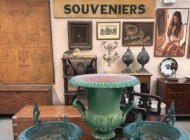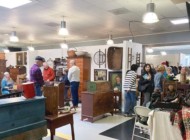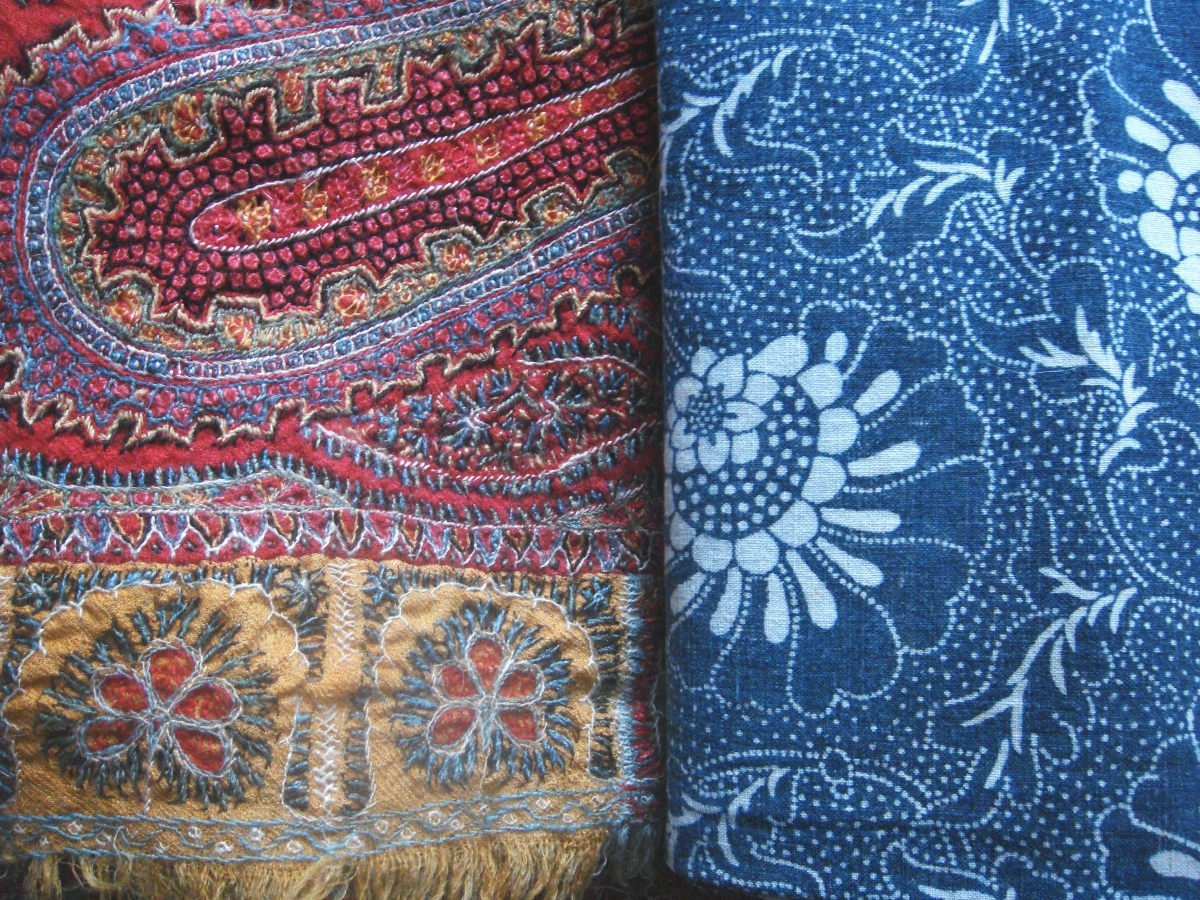
A detail photo of two textiles with Martin Platt, Xanthus Antiques. On the left, a hand-woven and embroidered Kashmir shawl from India, on the right a Japanese stencil-resist indigo. Villanova, Penn.
Review by Madelia Hickman Ring, Photos Courtesy Exhibitors
ONLINE & PENNSBURG, PENN. – Take a comparatively small show with a relatively narrow focus, add in a global pandemic and watch change happen. That was the case June 4-6, when, for the eighth time in nine years, the Schwenkfelder Library and Heritage Center benefited from the Penn Dry Goods Market (PDGM). The antique show and program series pivoted to a virtual event because of the pandemic and, in doing so, the event grew in ways it might not otherwise have done had it continued as another live show.
The Schwenkfelder Library & Heritage Center – the show’s traditional venue – can typically house about two dozen exhibitors and usually welcomes a few hundred visitors, most from within a short drive of Pennsburg. An online version does away with spatial constrictions and geographic parameters. As a result, the online version hosted 36 dealers and was visited by 5,300 people. About 20 percent of the items featured – dealers could post up to 30 items – sold for a total of about $66,000. About a dozen of the exhibitors had done the PDGM beforehand but the rest were new to the show, including its first-ever Canadian vendor, Timber River Farm of Timber River, New Brunswick.
The show did not stop with simply expanding its roster of dealers; it broadened the scope of the fair to include books and small pieces of Americana beyond the typical offerings of quilts, samplers, boxes, rugs, textiles and textile ephemera.
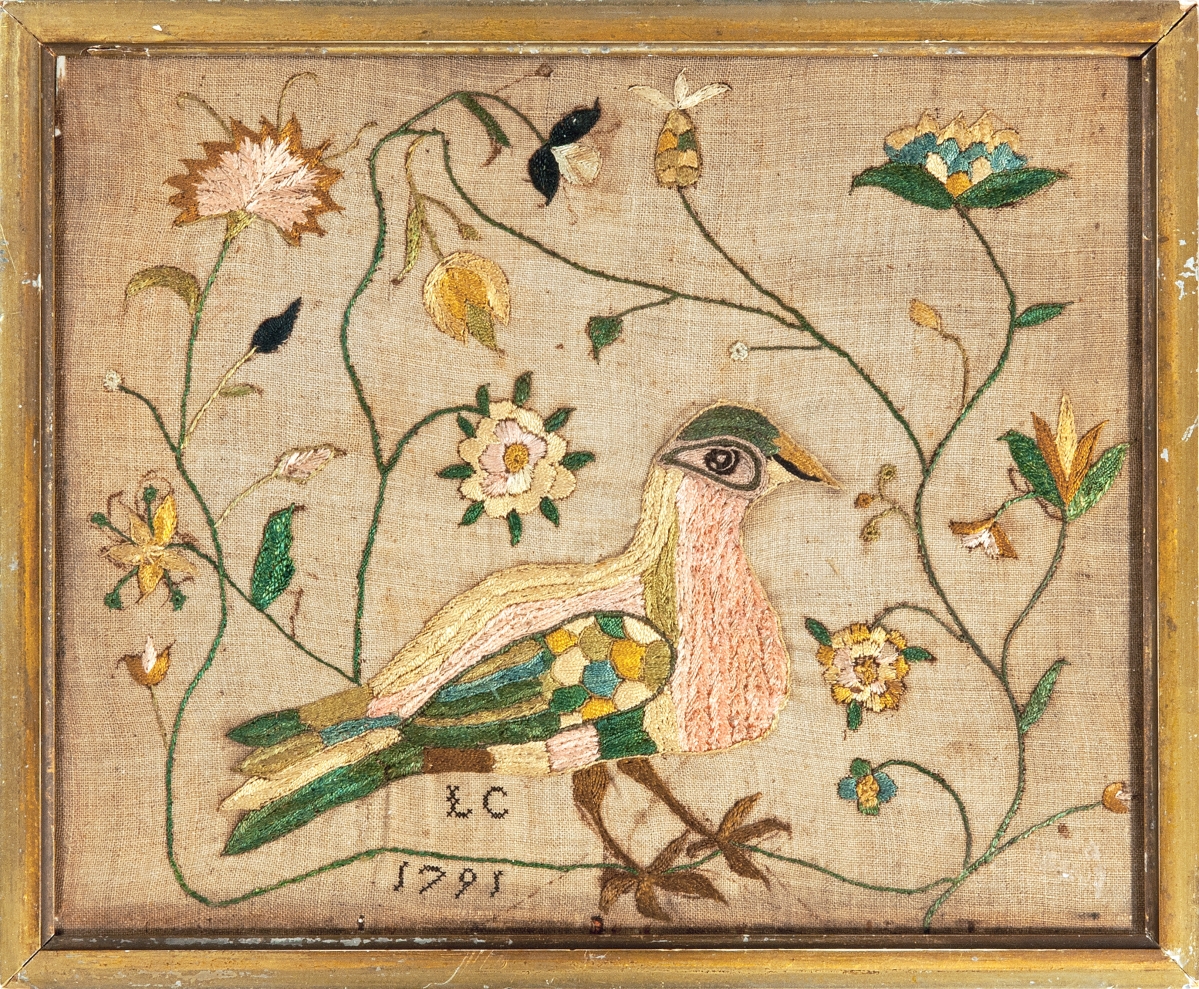
Old Saybrook, Conn., needlework dealers Stephen and Carol Huber were offering this needlework picture worked by LC in 1791 in Philadelphia. Carol said it resembles the work of Mary Flower, whose needlework and sketch book are in the collection of Winterthur Museum.
The main annual fundraiser for the Schwenkfelder Library and Heritage Center, the show typically makes money from ticket sales, dealer fees, lecture fees and corporate sponsorship. This year, profits were limited without revenue from ticket sales, but Schwenkfelder Library and Heritage Center executive director Beth Twiss Houting said the show and lecture series were a success.
“It was a great event. Both the antique show and lecture series went well, and both allowed us to expand our reach internationally, which was exciting.” She noted that while expectations for the 2021 edition were less than the 2019 show, the results were “higher than what I expected; our expectations were more than met.”
Houting said they sold nearly 850 tickets to the lecture series, which tallied 14 in all, an increase from the 11 offered in 2019. She noted that they used the Evvnt website (https://evvnt.com) to help promote the show and lecture series.
Antiques and The Arts Weekly touched base with Marvin Getman, who has been using his online platform (www.antiqueandbookfairs.com) for book fairs and antiques shows for nearly a year. He noted that the show’s website received 125,000 page view, with 50 percent of the show’s traffic taking place on Friday, 17 percent on Saturday and 33 percent on Sunday; the uptick in traffic on the last day can be attributed to his practice of asking dealers to post three fresh items on the morning of the last day. His statistics showed that 53 percent of visitors were younger than 35. Another statistic that identifies a potentially broadening market was that more than half – 54 percent to be exact – of attendees were male. For a show that has historically drawn a predominantly female audience, that’s an interesting trend to monitor in the future.
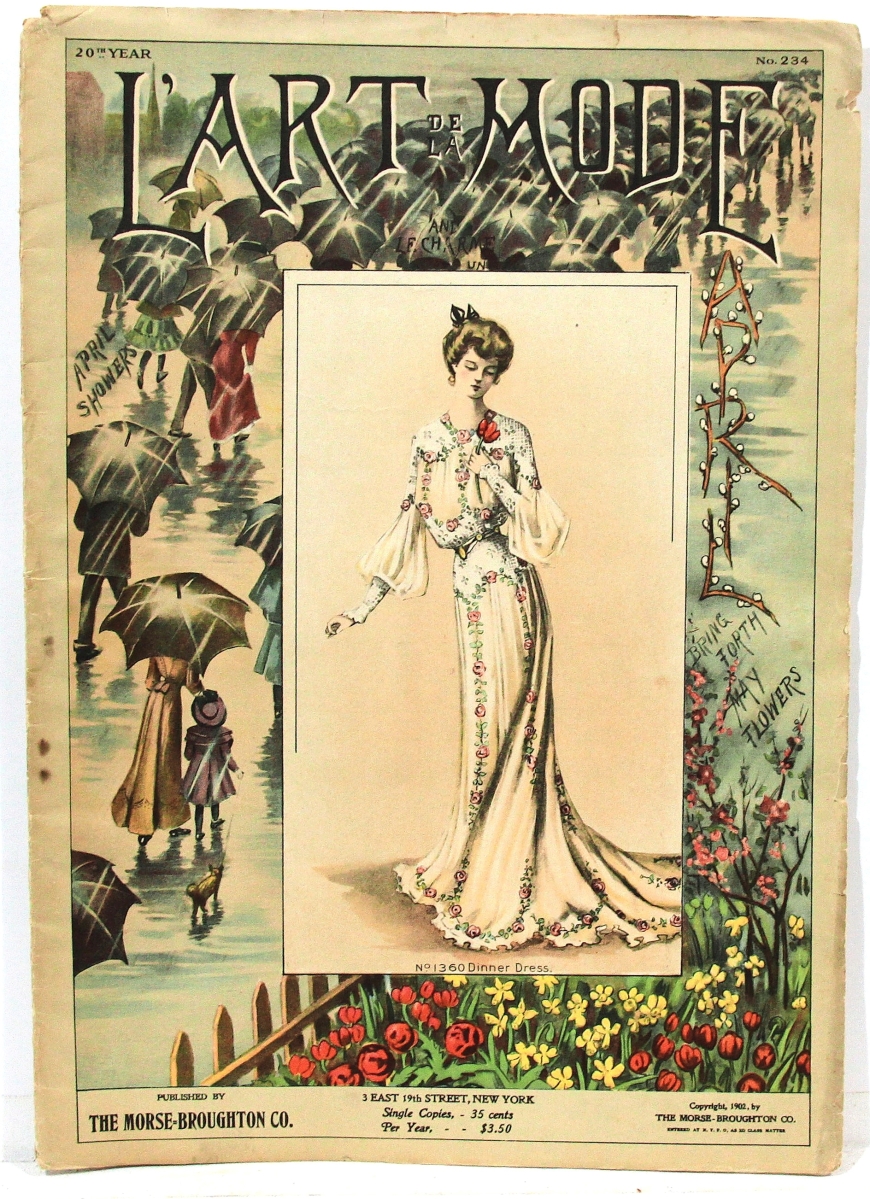
Still available with Jim Lyman was this folio size 1902 edition of L’Art de la Mode (The Art of Fashion) in French, but all text is in English. Published by Morse-Broughton Co of New York. He was asking $65 for it. A Page From The Past, Tempe, Ariz.
Getman noted that he had increased his advertising on Facebook and the show drew attendees most prominently from New York City, Philadelphia, Chicago, Washington DC, Los Angeles, San Antonio and Seattle.
A few exhibitors noted that modestly valued items saw considerably more interest than those at higher prices. When we asked Getman if he could see trends in how the different value brackets were selling, he said he saw only one sale at or above $5,000 and several sales between $2,500 and $5,000; most sales were of items priced below – sometimes well below – $2,500.
South Dennis, Mass., dealers David and Jane Thompson have been selling in Getman’s online antiques shows since he started them and typically do quite well; this show was no exception. They wrote up numerous sales, including school mottoes, glass darners, crochet and weaving manuals, samplers, purses, blankets and some cloth-covered books. Thompson said, “although the in-person shows are coming back fast, it is still fun to do the virtual antiques shows for reasons such as this: we sold one item to a collector who lives in California but was at her second home on the Colorado River in Arizona. So, we were looking at Cape Cod Bay and she said she was looking at the Colorado River!”
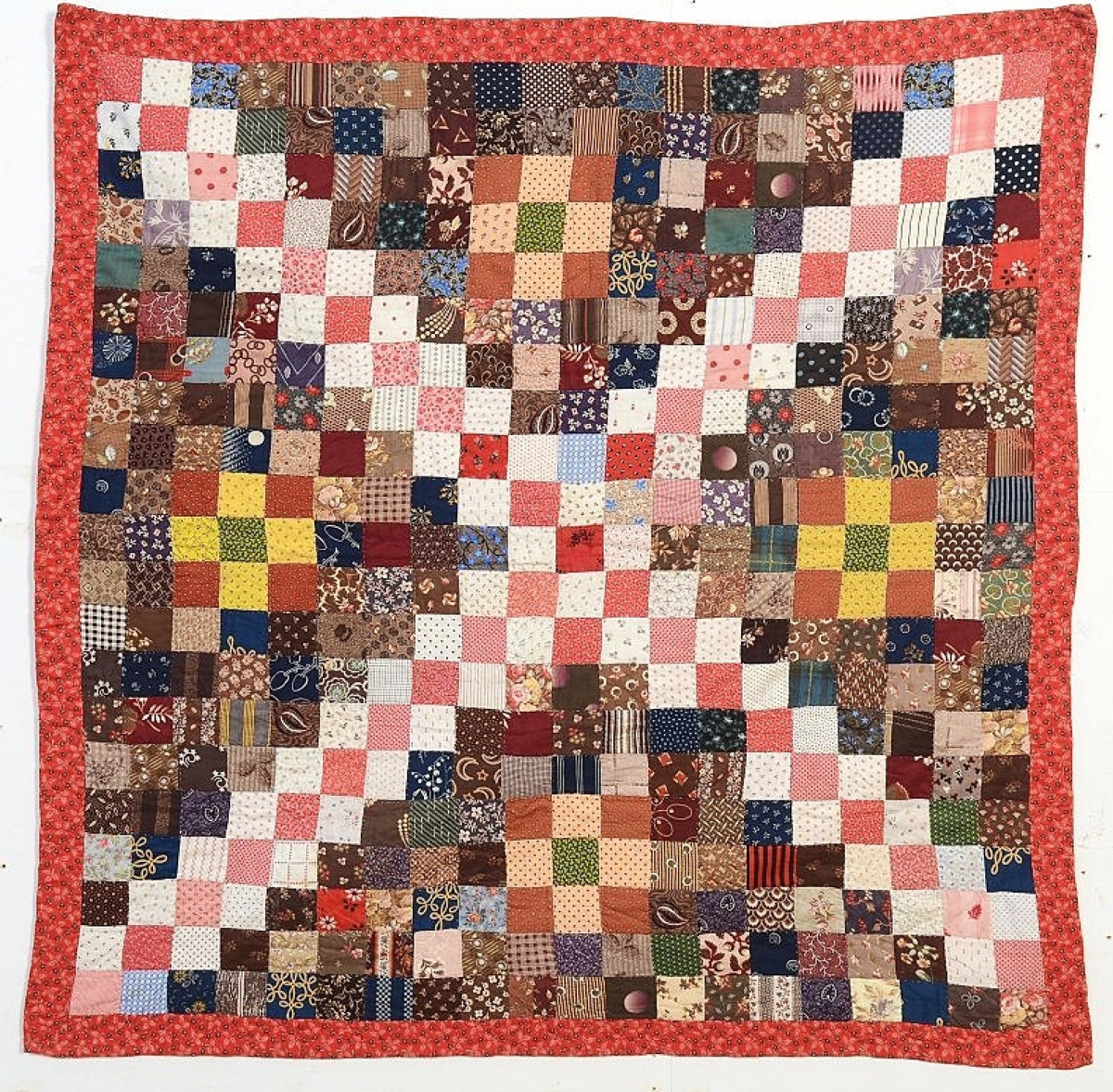
Darnestown, Md., quilt dealer Stella Rubin had this one patch crib quilt. At press time it was still available.
Another dealer who has been doing Getman’s online antiques shows from their inception is Debbie and Jim McArdle of Iron Horse Antiques. Like Thompson, Debbie McArdle seems to have figured out what will sell and routinely moves a high percentage of their booth. Sales tallied included a flying squirrel cage, blankets and quilts, stoneware, a rag rug and a pantry box, with sales to Pennsylvania, Virginia, Texas, South Carolina, Illinois and Wisconsin.
“This (show) was different,” McArdle said in a follow up email. “With this show I had fewer dealer sales and more end-user sales. Seven of my sales were to ‘new-to-me’ customers from all over the country and I discovered most of them learned of the show through social media. Obviously, Marvin’s Facebook ad worked to reel in new and younger customers as reflected in his analytics.”
Jim Lyman is a book dealer in Tempe, Ariz., who has done four other online sales on Getman’s platform but has never sold at the PDGM. He had reserves on two things within the first hours of the show opening and tallied several sales by the time the show closed, including several pieces of advertising ephemera of dry goods and textile books. He noted that all of his sales were to new clients. “This is an entirely new marketplace for me, and I would love to see it continue,” he said.
Judi Stellmach of Blue Dog Antiques in Stafford Springs, Conn., also had sales early in the show. She reported selling ten of the 30 things she posted, including some miniature silk potholders, an Eighteenth Century crewel wallet pocketbook, a linen and calico woman’s pocket and a collection of six antique calico doll’s aprons. “We are pleased. The format is easy to use, and help was available as needed. We had mostly new customers, so that’s a plus,” Stellmach said.
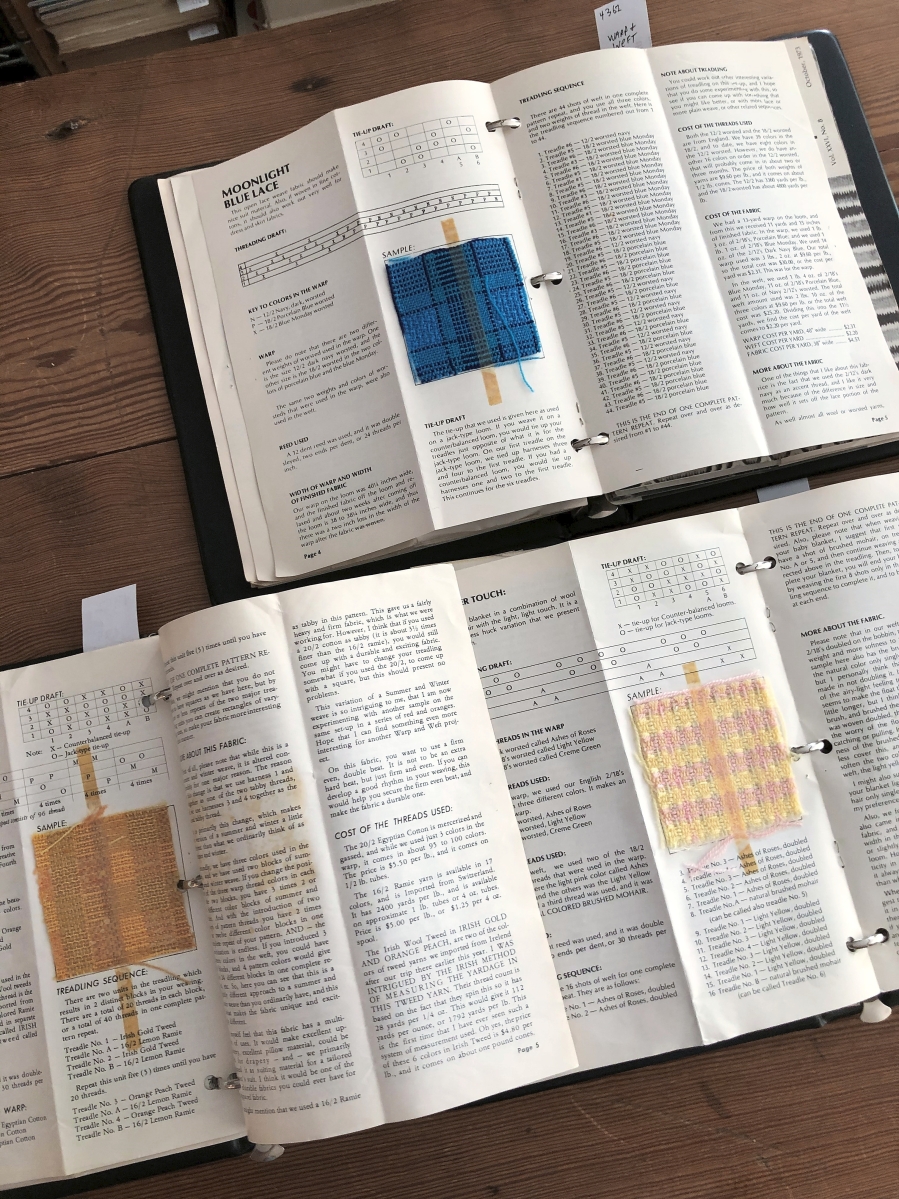
In search of issues of Warp and Weft magazine? See James Oberschmidt, Carydale Books, Rhinebeck, N.Y.
David Weiss of David M. Weiss Antiques, Sheffield, Mass., made his online show debut at PDGM, which he was doing for the first time. He sold one thing – an Ethan Allen horse weathervane – to a new client. He noted that the platform was easy to use and that both Getman and Houting were helpful and great to work with. Depending on when the show takes place next year, he said “if the online show goes again next year, I would definitely consider it.”
Cathy Cosentino, the only Canadian dealer in the show, sold a few things and had nothing but positive things to say about the show.
“This was my first time doing the Penn Dry Goods Show. Beth was lovely to deal with. I have done both Fox Valley’s and the NY Show on Marvin’s platform. Having done his real time shows around Boston long ago, it was no surprise to me that this virtual platform was an excellently administered and dealer/customer friendly venue. This show I sold one piece to a long-time dealer friend and my other sales were to new, very pleasant buyers, all very knowledgeable and interested. All of the sales were textiles. Being at a show new to me, it was interesting to see the diversity of what was offered and what sold. It was a good experience and I’d be happy to partake again.”
New Berlin, N.Y., dealer David Griffiths reported four sales, all to new clients. He said it was his second time doing one of Getman’s online sales, which he says is very easy to do and which links to his shop website.
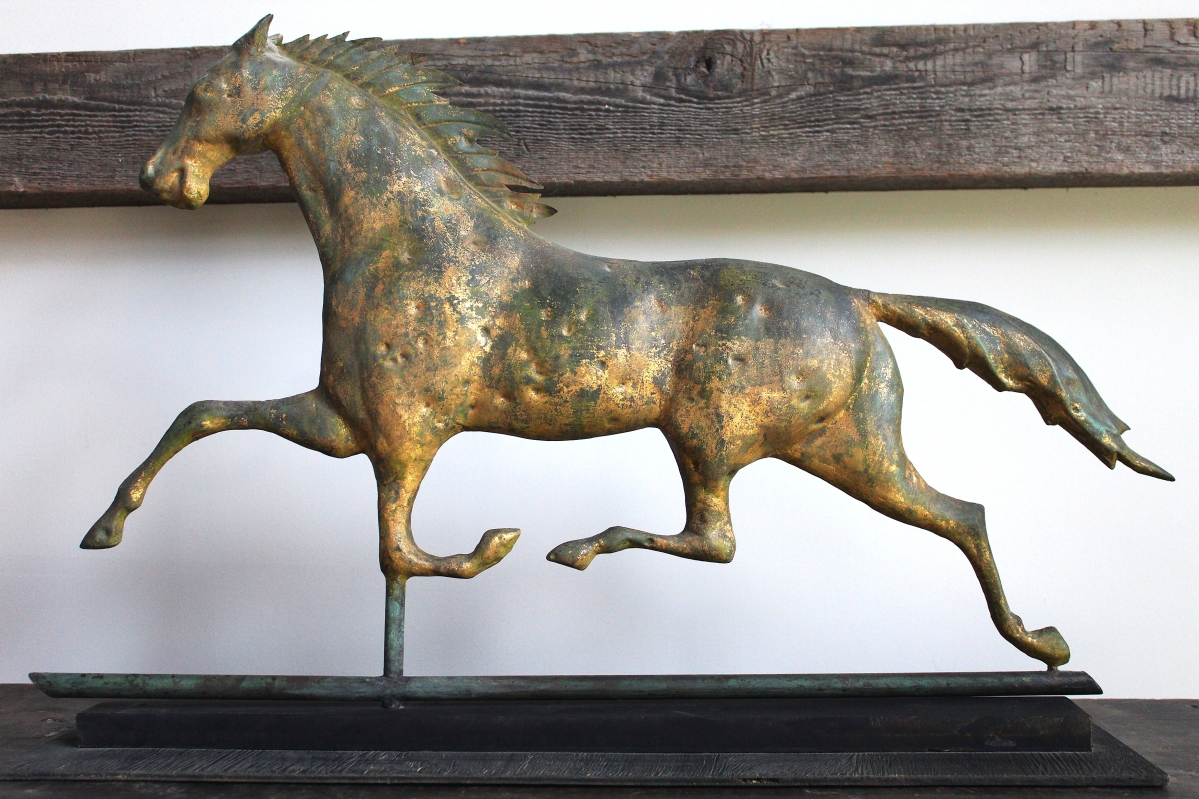
David Weiss closed the deal on this Ethan Allen weathervane with a new client. David M. Weiss Antiques, Sheffield, Mass.
“It has been a good show for me, selling to three customers in California (two of them new customers), and two new customers in Illinois, as well as sales in Pennsylvania and Texas,” Liz McElroy of JK Nevin Antiques said. “This is my first time doing this show, but I have attended the show as a buyer many times in years past. I was very excited to have the opportunity to join, because I’ve always loved this show! It’s also my first time using the Getman platform, and I must say I think it has been my favorite of the online shows I have participated in during Covid. It was easy to navigate for both dealers and customers.” The Chester County, Penn., dealer sold a pair of spun cotton birds, a painted country mirror, a miniature spongeware basket and a painted splint basket, among other things.
Kathleen Staples, who specializes in antique textiles and books in Greenville, S.C., also offered positive feedback on the show. “This was not my first show with Penn Dry Goods. I was very successful with my two previous shows. This year, all of my customers were new to me, and I sold to two museum institutions. This was also my first virtual show, and I really was surprised by the response to my offerings.” Her virtual booth had several things marked as sold or on reserve, including sewing machine advertising covers, an English canvaswork panel, an early Nineteenth Century sampler and two sets of engraved bone alphabet tiles.
“I liked working with Marvin Getman and the Pennsburg people are lovely,” said Jane Lury, who sent out a Dropbox link of photos of her quilts to existing clients, a strategy that generated lots of interest.
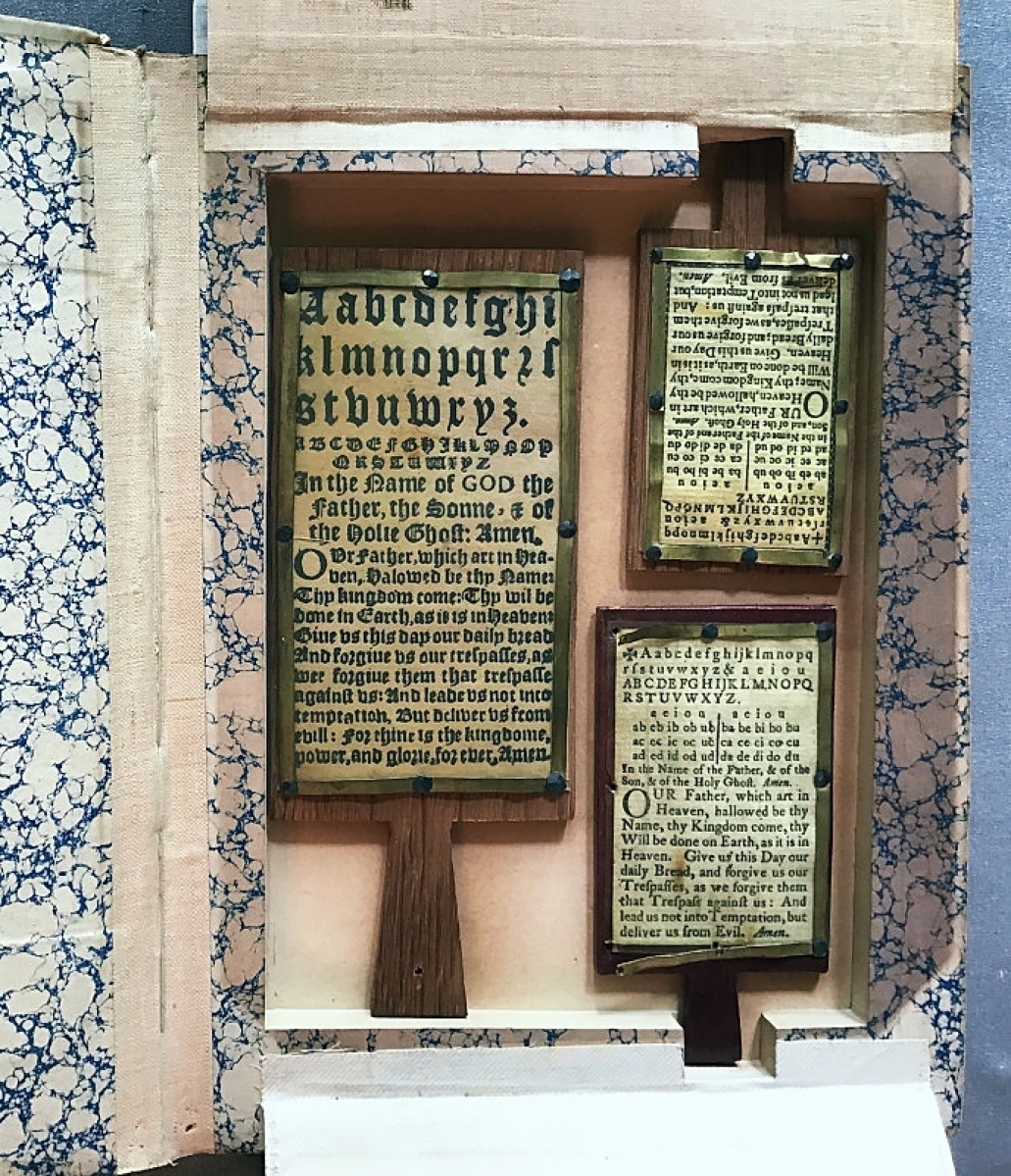
A Seventeenth Century English hornbook made of horn and paper was priced at $2,200 and still available. Kathleen Staples Fine Antique Textiles and Books, Greenville, S.C.
Randy Segotta of McClard Segotta Antiques said they were doing the PDGM for the first time and sold to existing clients. “PDGM is trying to diversify their appeal and we were happy to be able to do the show with them this year.”
Old Saybrook, Conn., sampler dealers, Stephen and Carol Huber, liked the online platform, which they said was easy to navigate. They noted that they specifically liked the lecture on hooked rugs by Kim Ivey and Marty Campanelli’s talk on Burlington County samplers.
Bill Subjack, Neverbird Antiques, has been doing the PDGM for years and he said he was “pleased with the results from the show. Our best sales were in the schoolgirl needlework category, of which we sold three examples, including two from states rarely seen.”
“Sales were good,” Karen Wendhiser said. “Most people who contacted us during the show bought the items they were interested in. All but one were new customers. Some dealers who we hadn’t seen in several years also contacted us about our items for sale. It was wonderful to speak to them again. We also were notified by people interested in items after the show closed.
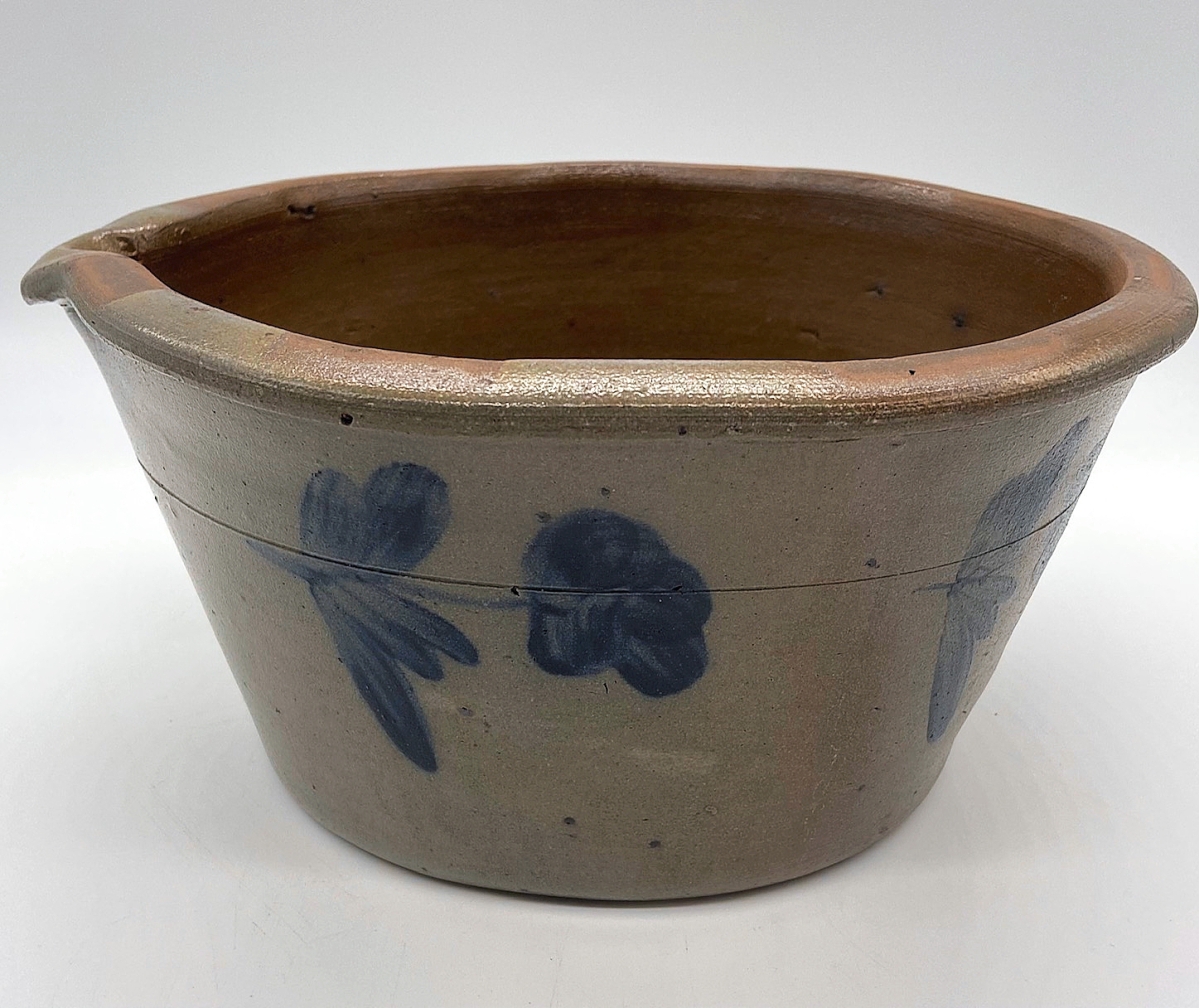
Something that Debbie McArdle sold right away was this Oxford, Chester County, Penn., salt-glazed stoneware milk pan, attributed to R.J. Grier of Mount Jordan pottery, circa 1870. Iron Horse Antiques, Woodstock, Ill.
“It was our first time doing the Penn Dry Goods Show. Also, our first time using Marvin Getman’s platform to do a virtual show. One of the reasons we decided to do the show was that we found his platform ‘user friendly’ for customers to peruse each booth, like ‘walking’ a live show. Customers can also easily navigate to find a particular dealer’s name, their booth or also find merchandise through categories. We feel that it is important for customers to be able to navigate the platform easily in order for a virtual show to be successful.”
Though Michael Pheffer, Two Sides of a River Antiques, only reported two sales, he said that both were to new clients who he felt would be long-term customers.
One of the only exhibitors to bring textiles from around the world was Martin Platt, Xanthus Antiques; it was his first time doing the PDGM. He sold a few things and thought the show was well organized by both the Schwenkfelder team and Getman.
Houting said they have not yet confirmed the date of the next Penn Dry Goods Market, but it would likely be the first weekend in June. For information, http://www.schwenkfelder.com/Penn-Market/.



























